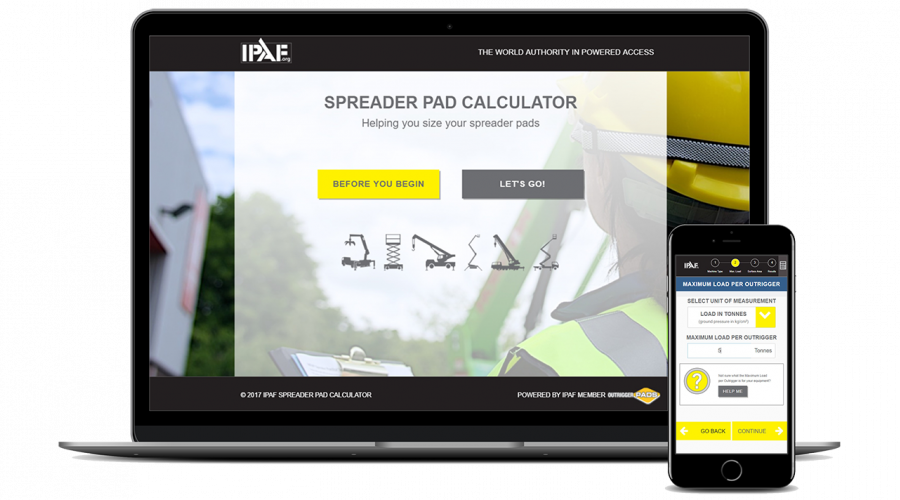Spreader Pad Calculator

Visit www.ipaf.org/pads to access the Spreader Pad Calculator
The IPAF “Spreader Pad Calculator” is a simple interactive tool designed to offer guidance to operators and those involved in determining the size of spreader pads to be used when setting up a boom-type MEWP where the weight will be fully supported on the outriggers, also known as jacklegs. After the gross vehicle weight of the MEWP has been entered, the Spreader Pad Calculator will display the minimum area of the spreader plate and identify minimum sizes of spreader pads required for differing ground types and strengths. Before using the device, an assessment of the ground strength should be conducted.
The correct assessment of ground strength can vary from a visual inspection of the ground surface to a full geotechnical survey. In the case of MEWPs, a visual inspection is often adequate, as outrigger loads are relatively low compared with machines such as mobile cranes. However, it is essential that the assessment is made by persons with adequate knowledge and experience to know when further expert advice and assessment is required.
Outrigger Foundations
The area of the foot attached to the outrigger of a MEWP is relatively small and consequently generates high pressures on the ground. Most soils, unmade ground and some paved and tarmac covered areas are not capable of supporting these pressures and some form of foundation or spreader pad is often required to reduce the pressure to an acceptable level. It is therefore strongly recommended that suitable spreader pads should always be used under the outrigger feet irrespective of the apparent ground conditions.
In addition, poorer ground conditions may require the advance preparation of additional foundations, such as timber mats, proprietary mats, steel grillages or concrete pads, before the MEWP outriggers are deployed. If timbers are used, these must be in good condition, dry and of adequate thickness (not scaffold boards).
Spreader pads should be of suitable strength and appropriate material to: a) prevent distortion when a load is imposed upon them and b) spread the load evenly across the whole area of the spreader plate.
It is recommended that spreader pads up to 600mm square or diameter should be at least 25mm thick. Spreader pads up to 900mm square or diameter should be a minimum of 50mm thick. Professional advice should be sought on the appropriate material for spreaders above 900mm.
For further information on ground conditions, please refer to IPAF's technical guidance on the assessment of ground conditions.
Visit www.ipaf.org/pads to access the Spreader Pad Calculator
Simple explanation of the relationship between Weight, Force and Pressure
- Weight – is measured in units such as pounds (lbs) kilogrammes (kg) tonnes (t.) and is a bodies mass or “heaviness” The weight of a specific MEWP will be shown in the manufacturer’s operator manual.
- Force – is a quantitative description of the interaction between two physical bodies, such as an object and its environment. E.g. the load that a MEWP will impose onto the ground through its wheels or outriggers. Common units of force used by manufacturers are: -dyne, kilogram force (kgf), lbf (pound force), newton.
- Pressure – is the force imposed over a given area. Common units of pressure are; kgf/centimetre2 , kgf/metre2 , lbf/foot2 , lbf/inch2 (psi), pascal, newton/meter2 . Spreader plates used with MEWPs outriggers, spread the force from the outrigger leg over the area of the spreader plate thus reducing the pressure of the MEWP on the ground.
- Ground load bearing capacity – is the maximum pressure a given area of ground can support. If the pressure pushing down on the ground from a MEWP spreader plate is greater than the ground load bearing capacity of the ground on which it stands, then the MEWP will become unstable and at risk of overturn.
Spreader Pad Calculator
The IPAF “Spreader Pad Calculator” is for guidance purposes only. Those responsible for assessing the ground and identifying the correct size of spreader plate to be used with any MEWP must do so in accordance with the manufacturers’ instructions and best practice guidance.
In accessing the IPAF “Spreader Pad Calculator”, the user acknowledges the above statement and agrees not to hold IPAF responsible for any damage, loss or injury that may result from incorrect assessment of ground conditions or incorrect selection and use of spreader pads.
